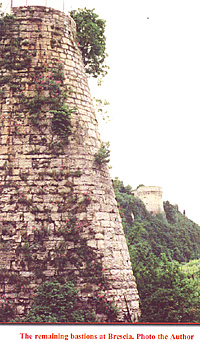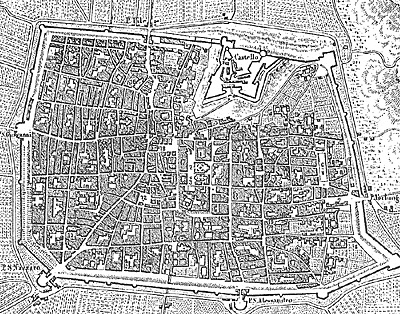The “Surprise of Brescia”
1796
“The Surprise Attack of Brescia
on 30 July 1796”
by Bernard Voykowitsch, Austria
| |
29 July 1796 when FM Wurmser marched off to the attack the French army in order to raise the French siege of Mantua the troops under his orders were divided in 4 main columns. Three of them advanced against the front of the French position between Lake Garda and the river Adige while the fourth went around Lake Garda in the west in order to fall into the rear of the French. The remaining bastions at Brescia. Photo the Author This last column gathered at Condino. Its commander FML Quosdanovich divided the 4th Column into four sub-columns and two advance-guards; of the last two the one advancing against Brescia was commanded by Count Klenau then (in 1796) colonel-commander of the Wurmser HR and today (1811!) member of the Court War Council. The task of the 4th Column was very important; in one case she might decide a battle of doubtful outcome, and in case of an Austrian victory she might exploit that victory. In case of a defeat the salvation of the army might depend on her as she might attract the attention of the enemy pursuing the army. On the other hand it could not be denied that 4th Column was too separated from the others as to count on a timely co-operation. That caused that she ran the danger to sacrifice itself in vain especially when the enemy learned about her arrival too early. These may have been the deliberations that caused General Quosdanovich to stop the advance as early as after the first day of the offensive in order to await news from the other columns. When this happened the Advance Guard under Colonel Klenau was only 5 hours distant from Brescia. Everybody in this command was impatient to undertake something against this town which was to the rear of the French frontline and had been turned into a depot for every kind of provisions. All the more one believed in success as Hauptmann Uihazy of the quartermaster staff held secret connections into the town which gave him the most detailed insight into the situation of the French there. (According to Quosdanovich Uihazy generally displayed eagerness and wisdom during the Castiglione campaign. Uihazy received a mortal wound at Mannheim in 1797 and died from his wounds.) Under these circumstances it is easy to understand that the order to halt was not very welcome within Colonel Klenau’s advance guard. Colonel Klenau who did not easily miss an occasion to add to the glory of the army he was serving decided also this time not to let the advantageous moment slip unused. Convinced that only insecurity about success had motivated FML Quosdanovich to order the halt he just awaited additional encouraging information in order to execute on his own responsibility a raid that not only should raise the morale of his own soldiers but in any case had to have a positive influence on the further operations. It was already midnight and the Austrian advance guard was still awaiting the information. Finally the sought for reconnaissance arrived: that as usually the French were very careless and did not expect any attack as the gates were only closed by a light lattice gate. That was enough. Klenau gave the order to march off. He sent Hauptmann Morocz with 70 Mahony Jaeger and Lieutenant Vlasich with 30 volunteers of IR37 Devins ahead and followed with 2 squadrons of HR5, and the battalion of IR37. In the morning when the Austrians arrived near Brescia, a thick fog hid the Imperials and prevented their premature discovery. 1 kilometre from Brescia a pedestrian coming from the town was encountered; he was immediately examined sharply and as his testimony confirmed the other information Colonel Klenau put at the head of the two squadrons of HR5 and rode against Brescia’s northern or “le Pile” gate at the full gallop. A French sentry outside of it gave fire but was sabred down immediately. Klenau had Oberlieutenant Deseritzky with 30 hussars gallop frontally against the gate. Rittmeister Steingruber with one half-squadron was ordered to ride to the French camp La Fiera to the right or west of the town while a second half-squadron was ordered to go also thither to the left or east and around the town. The French gate watch had found time to close the gate; six Austrian Hussars equipped with axes dismounted and tried to open it. Soon later the Mahony Jaeger lead by Hauptmann Morotz and the IR37 volunteers under Lt Vlasich arrived at the full run. After a few minutes the door was hacked open. Oberlieutenant Deseritzky immediately galloped in to the middle of the town. Some Austrian hussars rode onto the ramparts on both sides in order to silence any resistance from there. The Jaeger and the volunteers of IR37 followed the hussars and occupied the most important points. The consternation in the town and the disorder among the French was extraordinary. French soldiers and officers some with-out weapons, some without their hats some only half dressed could be seen running in the side roads. They all ran to save themselves. Coaches were driving through narrow streets in order to gain the open field, elsewhere others were halted by Austrian hussars and escorted back to town; others released their horses or cut them off in order to save at least their person. At the French camp la Fiera which was placed outside the town there was considerable resistance; yet Rittmeister Steingruber defeated the French in a short fight and pursued them on the road to Bergamo where they tried to rally but were totally dispersed. In the meanwhile also the mass of the Austrian infantry had arrived; it was one battalion of IR37 of which one division (i.e. 2 coys) was ordered to occupy the gates and the ramparts; one company took a position between the gates of San Giovanni and la Fiera; another took a position on the mountain of Ronchi which is to the east of the town; the last two companies lined up beneath this mountain in order to observe the road to Ponte San Marco; one troop of the hussars was sent further down this road, three troops remained in reserve. Within less than an hour and with own casualties of 3 killed and 10 wounded Brescia had fallen into the hands of the Austrians. From their windows the inhabitants of Brescia had watched this rare military spectacle. They were not in the least violated in their property or disquieted in their houses by the victorious Austrians. Tranquility restored they showed their gratitude to the Austrians on every occasion. Taken prisoner were 3 French generals among whom Murat and Lannes (Murat was sick so he was released on parole), 2 adjutant-generaux (Kellermann, Lasalle), 4 colonels, 2 commissaires de guerre, 4 secretaries, 30 other officers, 6-700 men (4 coys 25e de Ligne, 1 sqn 24e Chasseurs). The material spoils consisted of 400 barrels of flour, big stocks in wine, bacon and other victuals; 500 muskets, several artillery pieces and a considerable uniform depot. So far Neipperg’s account. The second text is an excerpt from Lt-Col E. Desbrière and Cpt M. Sautai, La cavalerie sous le Directoire, Paris-Nancy 1911. This book is a compelling analysis of the campaigns of the period that shows how much French revolutionary armies suffered from the deficiencies of their cavalry arm; deficiencies that were only cured by Napoleon.
Town plan of Brescia The “Surprise of Brescia” 1796
“The Surprise Attack of Brescia on 30 July 1796” Offensive de Wurmser, Castiglione (pp. 283-288) The Pursuit after Castiglione Back to Table of Contents -- First Empire # 75 Back to First Empire List of Issues Back to MagWeb Master Magazine List © Copyright 2004 by First Empire. This article appears in MagWeb.com (Magazine Web) on the Internet World Wide Web. Other articles from military history and related magazines are available at http://www.magweb.com |

